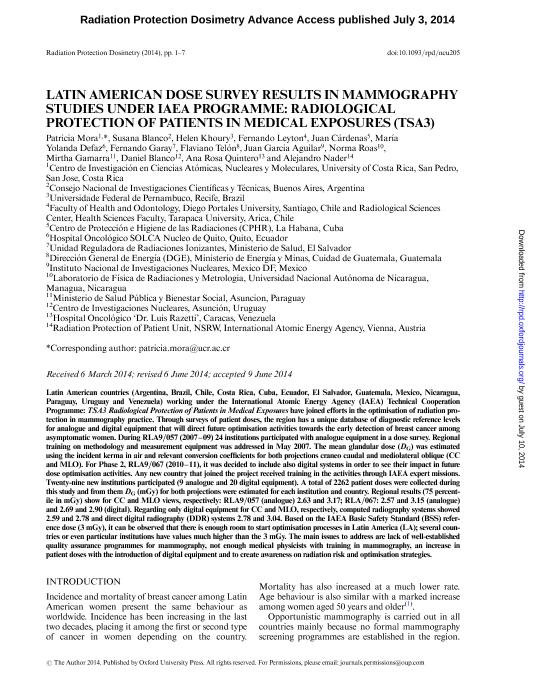Mostrar el registro sencillo del ítem
dc.contributor.author
Mora, Patricia
dc.contributor.author
Blanco, Susana Alicia Ana

dc.contributor.author
Khoury, Helen
dc.contributor.author
Leyton, Fernando
dc.contributor.author
Cárdenas, Juan
dc.contributor.author
Defaz, María Yolanda
dc.contributor.author
Escobar, Carolina
dc.contributor.author
Flaviano Telón
dc.contributor.author
García Aguilar, Juán
dc.contributor.author
Roas, Norma
dc.contributor.author
Gamarra, Mirta
dc.contributor.author
Blanco, Daniel
dc.contributor.author
Quintero, Ana Rosa
dc.contributor.author
Nader, Alejandro
dc.date.available
2020-04-29T13:53:11Z
dc.date.issued
2014-06
dc.identifier.citation
Mora, Patricia; Blanco, Susana Alicia Ana; Khoury, Helen; Leyton, Fernando; Cárdenas, Juan; et al.; Latin American dose survey results in mammography studies under IAEA Programme: Radiological Protection of Patients in Medical Exposures (TSA3); Oxford University Press; Radiation Protection Dosimetry; 6-2014; 1-7
dc.identifier.issn
0144-8420
dc.identifier.uri
http://hdl.handle.net/11336/103885
dc.description.abstract
Latin American countries (Argentina, Brazil, Chile, Costa Rica, Cuba, Ecuador, El Salvador, Guatemala, Mexico, Nicaragua, Paraguay, Uruguay and Venezuela) working under International Atomic Energy Agency (IAEA) Technical Cooperation Programme: TSA3 Radiological Protection of Patients in Medical Exposures have joined efforts in the optimization of radiation protection in mammography practice. Through surveys of patient doses, the region has a unique database of diagnostic reference levels for analog and digital equipment that will direct future optimization activities, towards the early detection of breast cancer among asymptomatic women. During RLA9/057 (2007-2009) 24 institutions participated with analog equipment in a dose survey. Regional training on methodology and measurement equipment was addressed in May 2007. Mean glandular dose (DG) was estimated using the incident kerma in air and relevant conversion coefficients for both projections craneo caudal and mediolateral oblique (CC and MLO). For phase two, RLA9/067 (2010-2011), it was decided to include also digital systems in order to see their impact in future dose optimization activities. Any new country that joined the project received training in the activities through IAEA expert missions. 29 new institutions participated (9 analog and 20 digital equipment). A total of 2262 patient doses were collected during this study and from them DG (mGy) for both projections were estimated for each institution and country. Regional results (75 percentile in mGy) show for CC and MLO respectively: RLA9/057 (analog) 2.63 and 3.17; RLA/067: 2.57 and 3.15 (analog) and 2.69 and 2.90 (digital). Regarding only digital equipment for CC and MLO respectively, computed radiography (CR) systems showed 2.59 and 2.78 and direct digital radiography (DDR) systems 2.78 and 3.04. Based on the IAEA Basic Safety Standard (BSS) reference dose (3mGy), it can be observed that there is enough room to start optimization processes in Latin America (LA); several countries or even particular institutions have values much higher than the 3mGy. Main issues to address are: lack of well established Quality Assurance (QA) programs for mammography, not enough medical physicists with training in mammography, an increase in patient doses with the introduction of digital equipment and to create awareness on radiation risk and optimization strategies,
dc.format
application/pdf
dc.language.iso
eng
dc.publisher
Oxford University Press

dc.rights
info:eu-repo/semantics/openAccess
dc.rights.uri
https://creativecommons.org/licenses/by-nc-sa/2.5/ar/
dc.subject
MAMMOGRAPHY
dc.subject
QUALITY CONTROL
dc.subject
MEAN GLANDULAR DOSE
dc.subject
LATIN AMERICAN
dc.subject
IAEA
dc.subject.classification
Otras Ciencias de la Salud

dc.subject.classification
Ciencias de la Salud

dc.subject.classification
CIENCIAS MÉDICAS Y DE LA SALUD

dc.title
Latin American dose survey results in mammography studies under IAEA Programme: Radiological Protection of Patients in Medical Exposures (TSA3)
dc.type
info:eu-repo/semantics/article
dc.type
info:ar-repo/semantics/artículo
dc.type
info:eu-repo/semantics/publishedVersion
dc.date.updated
2020-04-28T14:19:37Z
dc.journal.pagination
1-7
dc.journal.pais
Reino Unido

dc.journal.ciudad
Oxford
dc.description.fil
Fil: Mora, Patricia. Universidad de Costa Rica; Costa Rica
dc.description.fil
Fil: Blanco, Susana Alicia Ana. Consejo Nacional de Investigaciones Científicas y Técnicas; Argentina
dc.description.fil
Fil: Khoury, Helen. Universidade Federal de Pernambuco; Brasil
dc.description.fil
Fil: Leyton, Fernando. Universidad Diego Portales; Chile. Universidad de Tarapaca.; Chile
dc.description.fil
Fil: Cárdenas, Juan. Centro de Protección e Higiene de las Radiaciones; Cuba
dc.description.fil
Fil: Defaz, María Yolanda. Hospital Oncológico Solca Núcleo de Quito; Ecuador
dc.description.fil
Fil: Escobar, Carolina. Unidad Reguladora de Radiaciones Ionizantes; El Salvador
dc.description.fil
Fil: Flaviano Telón. Ministerio de Energía y Minas. Dirección General de Energía ; Guatemala
dc.description.fil
Fil: García Aguilar, Juán. Instituto Nacional de Investigaciones Nucleares; México
dc.description.fil
Fil: Roas, Norma. Universidad Nacional Autónoma de Nicaragua; Nicaragua
dc.description.fil
Fil: Gamarra, Mirta. Ministerio de Salud Pública y Bienestar Social; Paraguay
dc.description.fil
Fil: Blanco, Daniel. Centro de Investigaciones Nucleares; Uruguay
dc.description.fil
Fil: Quintero, Ana Rosa. Hospital Oncológico ‘Dr. Luis Razetti’; Venezuela
dc.description.fil
Fil: Nader, Alejandro. Organización de Las Naciones Unidas; Argentina. International Atomic Energy Agency; Austria
dc.journal.title
Radiation Protection Dosimetry

dc.relation.alternativeid
info:eu-repo/semantics/altIdentifier/doi/http://dx.doi.org/10.1093/rpd/ncu205
dc.relation.alternativeid
info:eu-repo/semantics/altIdentifier/url/https://academic.oup.com/rpd/article-abstract/163/4/473/1598675?redirectedFrom=fulltext
Archivos asociados
